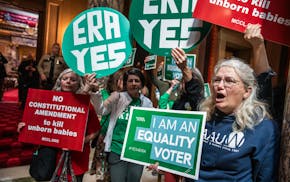One of the most memorable moments during the recent Democratic presidential debates likely left viewers with an unfortunate misunderstanding about a vital issue: health care. Clarification is critical because rising costs for coverage and care require urgent fixes. What those are will be a key focus of the 2020 campaign.
Health care regrettably got short shrift during the two forums televised about a week ago. When it did come up, the moderators requested a show of hands. The question: How many candidates were willing to jettison private health insurance and replace it with a government-run plan? Four candidates put their arms in the air — New York City Mayor Bill DeBlasio and Sens. Elizabeth Warren, Bernie Sanders and Kamala Harris. A day later, Harris backtracked, saying she misunderstood the question.
The scenario made for compelling TV, but it created a false choice. It's simply not true that there are only two paths forward — keeping the current system, which relies heavily on employer-provided private health insurance or rebooting completely with a government-run plan. An example of what the latter could look like: putting everyone into Medicare, the federal government's popular health insurance program for seniors, and expanding the coverage it provides.
While this approach — embraced most vocally by Vermont's Sanders — has dominated the early 2020 Democratic campaign, there are multiple alternatives that involve building on the current system. Those options could substantively move the nation closer to universal coverage and do so without the massive disruption involved in a Medicare for All approach. They might also be more politically palatable outside of the progressive circles who have vocally embraced a sweeping, Sanders-style reform.
Essentially, these other avenues take a "buy-in" approach, which would maintain private health insurance for those who want it while offering expanded access to the nation's two main government-run health care programs — Medicare and Medicaid. Medicaid currently serves the poor, the disabled and elderly in need of long-term care.
Right now, Medicare is generally limited to Americans 65 and up. Medicaid has income limits. Expanding eligibility could provide a less expensive alternative to private coverage and potentially, more robust benefits. Cost savings could come from programs' size (together they serve more than 130 million Americans) and their leaner administrative and provider reimbursement costs.
Members of Congress have already introduced thoughtful buy-in legislation. A number of the Democratic presidential candidates are co-sponsoring them, which is why the superficial health care discussion during the first debates was frustrating.
Minnesota Sen. Amy Klobuchar, a 2020 Democratic presidential contender, tried valiantly to point out the buy-in alternatives. She has co-sponsored both Medicare and Medicaid buy-in legislation. But Klobuchar's debate time was limited and moderators didn't follow up.
Another contender in the crowded field, former Maryland Rep. John Delaney, merits praise for trying to keep the discussion going. He noted correctly that the buy-in approach isn't a slam-dunk. At issue is the public programs' reimbursement to hospitals and providers. It's often much lower than that provided through health insurance. Any buy-in approach would have to calibrate these concerns with consumer affordability.
The recent debates were merely the starting point in the 2020 campaign. There is plenty of time for more thoughtful discussion about the buy-in, Medicare for All and other measures to ensure affordable coverage.
Future moderators need to ensure that candidates can competently discuss the advantages and disadvantages of differing approaches, particularly with regard to cost. Voters should demand the same of candidates on the campaign trail.

Divestment is easier chanted than done
Pass guardrails for HCMC governance changes

Minnesota needs an ERA that includes gender and reproductive freedom

Legislature must clarify sex, gender before putting an ERA before Minnesota voters

